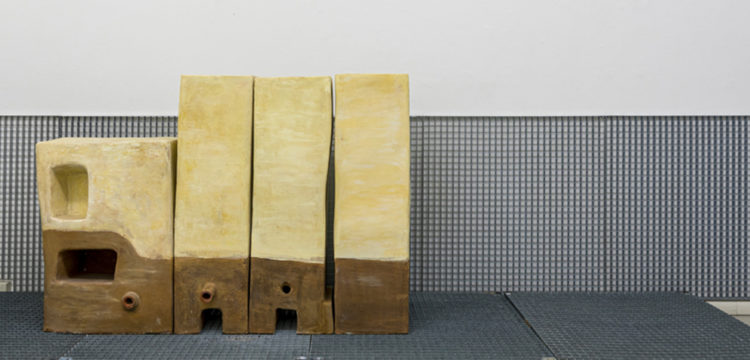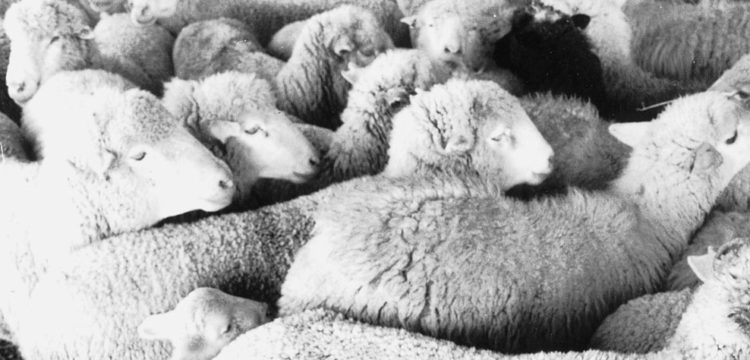Staying with the Shepherd
For a sustainable and ecological long-term maintenance of all forms of life
This text is part of a broader artistic research that investigates the role of material practices within a contemporaneity that constantly abstracts reality into immaterial relations of capital. Against the background of the capitalist logic of relating to the earth as an endless resource of continuous privatization, growth and expansion, considering “rural” forms of transgenerational, embodied knowledges and practices of relation to land guided by the logic of maintenance. The link between art and practices of relation to the earth is to be found in the act of generating a form of culture that directly deals with the sustainable and ecological long-term maintenance of all forms of life. As a potentially generative example of human re-connection to material forms of living, a specific vernacular practice of human subsistence has managed to survive until today: roaming pastoralism—the practice of raising animals while roaming through land, orally transmitted from one generation to another.
Despite the disruptions caused by property, pastoralism has managed to survive until today; by dealing with the law, both transhumance through public and private property, and occupying space illegally, roaming shepherds challenge the perception of land domain. They create a glitch in the “natural” movement of abstraction that drives our current relationship with the earth, coming closer to what would be the opposite of property according to Stefano Rodotà: a system in which access to common goods as well as their management and government are collective and don’t produce profit.
In September 2007, the World Gathering of Nomad and Transhumant Pastoralists held in the highland pasturelands of Granja, north of Madrid, hosted pastoralists from 38 countries and 50 tribes from Africa, America, Asia and Europe. As part of the gathering, 200 Spanish pastoralists and 1000 sheep walked through the center of Madrid in defense of two grazing routes that have enabled for centuries the transhumance across the city from north to south. The routes, along with 120,000km of Spanish cattle trails, are threatened with closure despite an Act of Parliament of 1995. The gathering was held to make visible the presence of pastoralists on the territory and defend their right to move across it.
For a roaming activity, the loss of access to the traditional pathways and of the right to enter both public and private properties brings about the loss of the means life production. The struggle of pastoralists to access grazing routes can be considered being related to the loss of a cultural shared understanding of what moving through a territory means in sedentary societies, but also a political attack against non-capitalist systems of production. Absurdly enough, the passage of livestock through what are now public city roads was the first step for the development of many urban areas. In the center and south of Europe, the open areas in the outskirts of cities like Rome, Vienna and Madrid are visible proof of the convergence of multiple ancient paths, opened by the activity of transhumant pastoralists.
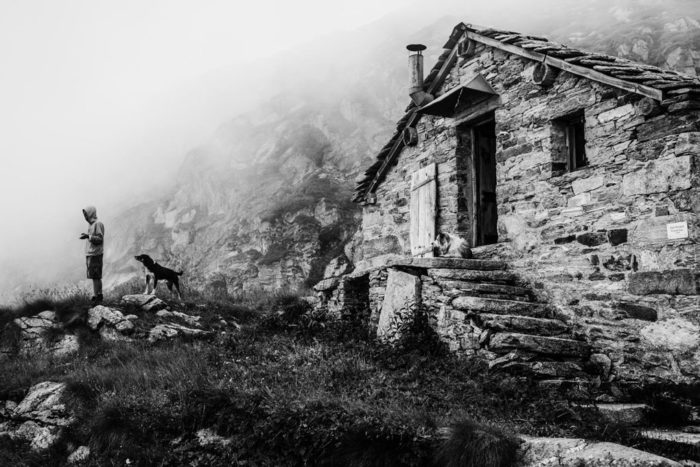
Gregorio, 34 years old shepherd, having a coffee out the shelter, up in the Biellese Alps. Photo by Nicolás Amaro. 2019.
Nevertheless, the massive gathering is also an example of how, in some instances, pastoralists manage to take advantage of the trans-territorial character of their routes to activate extended support networks. For instance, the Association of Wandering Shepherds of the Italian Alpine Arch was founded by pastoralists who operate across the Italian Alps, from the regions of Liguria, Piemonte, Lombardy, Friuli Venezia Giulia, Trentino-Alto Adige and Veneto. Their aim is to create a support network able to undertake actions against the bureaucracy of law. In this regard, researcher Sara Groen highlights the victory obtained by the Association to secure the transit through Parco del Ticino (between the provinces of Novara and Milan). The area is traversed by the river Ticino and it is situated within the larger fluvial area between Parco del Toce and Parco del Po, which has been a route of pastoral migration since the Middle Ages. Its recent status as a protected natural park and the consequent physical enclosure was heavily affecting pastoralists who had to request access in advance to every single municipality involved, often obtaining a negative response, while the park was being promoted for tourism as “the ancient transhumance route.” Thanks to the Association’s endeavors, the shepherds obtained the right to access the park, picking up the entrance keys at the town hall of Valdossola (Groen, Sara. “Sapersi Muovere. Un Caso di Pastorizia Transumante nel Piemonte Orientale.” Master thesis, Alma Mater Studiorum di Bologna, 2006-2007).
As Groen underlines quoting anthropologist Philip Carl Salzamann, the first reason for the pastoralists’ loss of access is a political one. The legal and coercive power remains in the hands of non-shepherds who are in a position that allows them to create and reinforce laws. The European Shepherd Network (ESN), a web of European shepherds and pastoral organizations (mentioned in section II), sets the political struggle as a major challenge: “All across Europe, we are getting organized into federations, building regional networks and gaining international recognition from leading institutions. We strive to defend the interests of local producers and to increase our political representation.”
In doing so, the ESN works in close contact with transnational institutions, including the Food and Agriculture Organization of the United Nations (FAO), demanding specific actions from policy makers, which connect ecological, economic and cultural factors that impact the lives of the pastoralists and—as discussed before—the broad surroundings involved in the pastoral system of maintenance. These policies include the promotion of artisanal production of traditional foods; the improvement and innovation in local markets and labelling systems; the respect for the pastoralists’ methods of breeding and identifying animals; the recognition of intangible cultural heritage; the inclusion of pastoralists in the making of decisions; the recognition of grass-root pastoralist organizations across Europe as partners; and stopping “land grabbing” and the restrictions on mobility that make it impossible to maintain a viable pastoralist system.
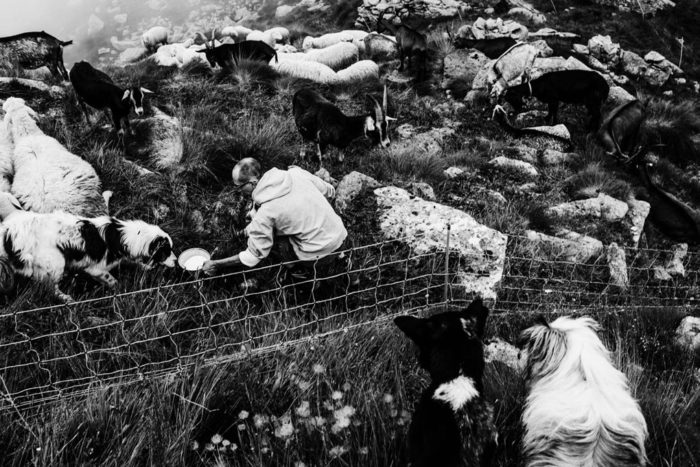
Gregorio feeds his dogs with fresh goat milk. Photo by Nicolas Amaro. 2019.
The ENS is currently coordinated by Inland, an artist collective based in Spain that is “dedicated to agricultural, social, cultural production, and collaborative agency” since 2009. But what does art have to do with pastoralism? What can aesthetic practices learn from the pastoralists’ materialist approach?
One of the members of the Inland collective is the artist Fernando Garcia Dory. With a background in sociology and archeological studies, Dory developed an artistic practice based on the research and development of social processes that deepen the field of socially-engaged art, and act within the structures already in place in small communities. Among the numerous projects that Dory is developing with Inland, there is a school for shepherds dislocated throughout the tops of the Urrielles Mountains, in the north of Spain. The project started by researching the depopulation crises of the local pastoral communities, followed by a year-long training in which Dory lived and worked with shepherds, testing his learning experience as a new form of education (2004). Since then, people who are interested in pursuing the pastoral activity can join advanced shepherds and learn directly from working with them in one-on-one temporary relationships of cohabiting in the shepherds’ mountain cabins.
Shepherding, normally considered as a knowledge that is not “taught,” but rather an activity that is orally “transmitted” from father to son, is taken outside the closed boundaries of a community circumscribed by blood relationships. Every time the shepherd meets the student, knowledge becomes “material,” in the sense that there is no translation or a representation of the pastoral tradition, but the just the materialization of it. The context and the conditions in which pastoralism happens is introduced to the “other,” the non-shepherd, by the processes of experiencing, understanding, and practically/materially producing. The work of pastoralists is shaped by the shepherd school as a real form of knowledge which, as such, can be recognized as practice-based. From the production of food to all the material operations of raising animals through a sustainable way of living, this form of education wants to convey the message that our reality is shaped by materiality, including dialogue, collaboration and assembly between people from different generations and cultures and sub-cultures.
The historical approaches of classical Western philosophy and of the Arts to the pastoral subject romanticize nature as a rational idea (Nature) that is separated from human existence and human activity (Culture). The same can be said for examples of contemporary socially-engaged artistic practices that are less attentive to the social, cultural and economic systems that inhabit rural landscapes. Terms that are often associated to the pastoral subject such “wandering” and “errant” create a romantic and misleading image that has little to do with the real material practice of maintenance of natural resources, based on a strategic approach. However, an aesthetic practice that promotes pastoral landscapes, rural locations, and locally produced products must necessarily depart from a research on the economy and economic history of a specific location—capitalism has developed through an increasing trend of accumulation, extraction and exploitation that has burdened both human societies and the Earth, deeply determining the way in which we relate to our environment today.
A cultural work made in or about the “rural” can go wrong in many different ways. The image of the white flock surfing the mountains often used by touristic advertisement can be as dangerous as any activity aimed at consumption without considering the pastoral landscape as a lived, traversed, used and cultural landscape. Art practitioners in a broad sense—workers in the visual arts, designers, socially-engaged artists and many others—should become capable of understanding how capital appropriates aesthetic codes in the name of economic progress. From there, the aim of art should be to change the status quo and work with the world’s complexity, towards the universal, sustainable maintenance of life.
The precarious situation of pastoralists as cultural subjects is one of the reasons why Inland’s shepherd school is about taking a political stance within the art world, as much as in front of institutions and organizations that control regional, continental and global land use. To this aim, as a further remark on how important collaborative relationships of “assemblism” are, the school is part of the Spanish Shepherds Federation (FEP) and the World Alliance of Mobile Indigenous Pastoralists (WAMIP).
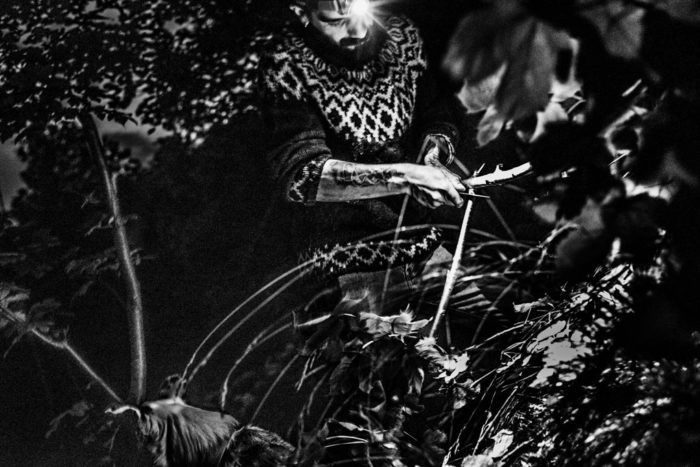
Marco sharpens a tree brunch to enforce the structure of the fence. Photo by Nicolas Amaro. 2019.
In my experience, the transhumance is a noisy and chaotic parade of many animals and few men that seem to come from nowhere and go towards the unknown, to a place somewhere beyond the end of the road that the moving mass seems to know how to reach. The Biellese transhumance, which crosses a rather large territory within a vertical geography, still traverses the big urban centers. Many shepherds still transhume entirely on foot, usually in the night, when authorities allow it just because the streets are clear from traffic.
The idea that pastoralists never learned to catch up with development and that they survive by going backwards is connected to the very meaning given by contemporary Western societies to “going forward,” or to the word “progress”. The shepherd is believed to be totally detached from civilization: part of Nature and outside of Culture. But the eye that looks at Nature from afar can easily romanticize what it sees and, in doing so, it might also validate the idea of the “rural” as a margin, as the end of possibilities, the impossibility of a future. Why “rural”? The question comes spontaneously, but the answer leads to more questions: what kind of relationship makes rurality, rural? Is a place rural in relation to what center?
Whatever the answer, the very act of staying on the move can be read as a tool to challenge marginalization/ruralization: temporarily occupying urban space, seasonally traversing the “civilized world.” The image of the roaming shepherd can work as a monitor to make pastoralism visible outside of the rural. Besides cheese and meat—which remain part of an extremely limited market anyway—roaming shepherding offers the city a way to relate to the pastoral world and to its system of environmental relations. Even though the transhumance of flocks is a migration of sorts, that goes on all year round, it would be a mistake to restrict it to the moment that I see it outside my balcony. The crossing of the city center has the disruptive potential of changing our spatial perception of property and land use, determined by law.
As discussed in Blomley’s Flowers in the bathtub, the crossing, occupying and passing through—the extra-ordinary/out-of-place—activates a multiplicity of ways in which we can relate to shepherds and perceive their position within the boundaries of society. As those boundaries are always dominated and maintained by the rule of property, when shepherds actively deal with the problem of access, and the bureaucratic instances that influence their movement, they also disrupt the idea that everything has a fixed place and, possibly, challenge our sense of self-determination in space. If we were at the end of the world, what would you use land for?
“Rather than an image, the roaming shepherd is walking knowledge that has survived the historical disembodiment and commodification of reality, in a path between the place of departure and the place of arrival.”
What if we try to reconsider the boundaries of the realm of culture and understanding pastoralism as one of the forms of knowledge, that could keep the relationship between humanity and the earth from disappearing? To do so, we need to rethink about how we look at things, repositioning ourselves spatially and mentally, as researchers, cultural producers, or even just observers. Advocating for a feminist position within the field of science, Donna Haraway states that “only a partial perspective promises objective vision.” The objective point of view, such as the eye of the scientist, the researcher, or in other words the eye that looks from outside, was created by Western cultural narratives that governed the world through through a distant but omnipresent look. Instead, Haraway proposes that object and subject shouldn’t be separated, they are part of how knowledge comes to be. If we believe that knowledge is produced within the body, “it allows us to be answerable of what we learn how to see.”
I read Haraway’s “learning how to see” in the continuous tense that distinguishes a process of constant becoming, rather than something limited or finished. The “object” of research is what I learn to understand by proximity, through the material form of myself, my body, and the body of what I am looking at, transforming it into a “subject.” Is Haraway trying to dismiss any kind of objectivity? No, but she says “that view of infinite vision is an illusion, a god trick.” As the first experiences of areal view contributed to the perception of land as a disposable commodity, the contemporary disembodiment of the eye in technological devises and “intelligence-linked graphic manipulation systems” reinforces an idea of knowledge that is separated from the subjects involved, alienating their participation in knowledge and dismissing the opportunity of material knowledge.
Starting from Haraway’s idea of “situated knowledge,” the image of the roaming shepherd should be understood and re-produced within a material logic: as a moving image that brings along the perception of something far from a digital reconstruction, and far from disposable commodities. Rather than an image, the roaming shepherd is walking knowledge that has survived the historical disembodiment and commodification of reality, in a path between the place of departure and the place of arrival.
If the world is dominated by the abstraction of property, roaming pastoralism disrupts the smooth continuity of western capitalist exploitation and materially acts in the “now” to provide a sustainable future. With the aim of enabling an artistic practice that makes true sense of reality, physical proximity to pastoralism can disrupt the process of abstraction and at the same time keep us connected to the very reason pastoralists exist: the maintenance of human life in coexistence with non-human life as a sustainable, long-term project.


